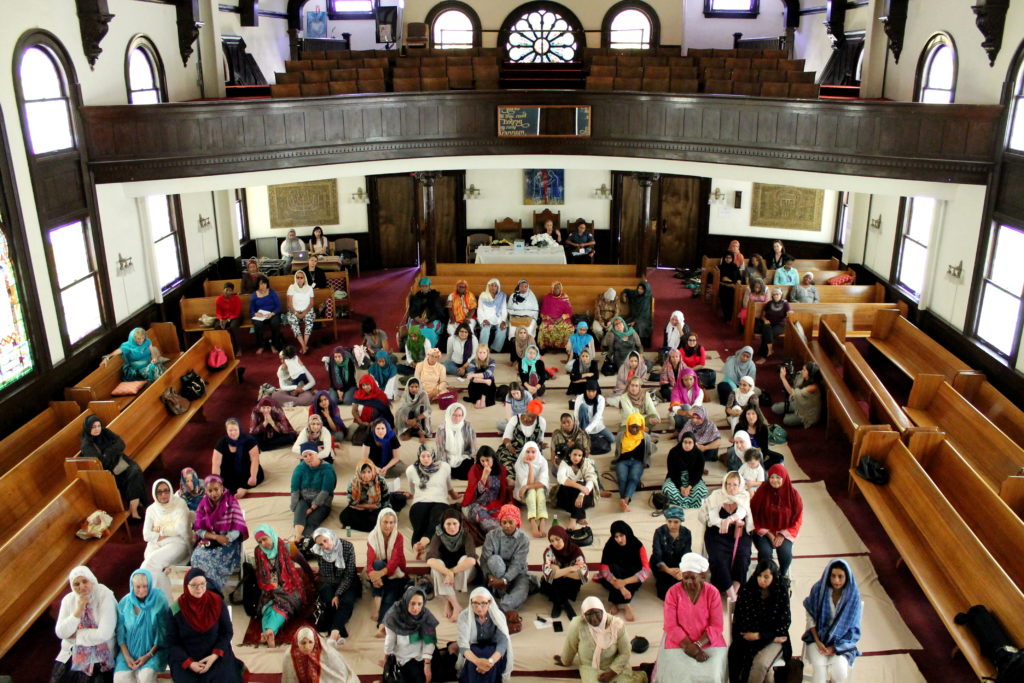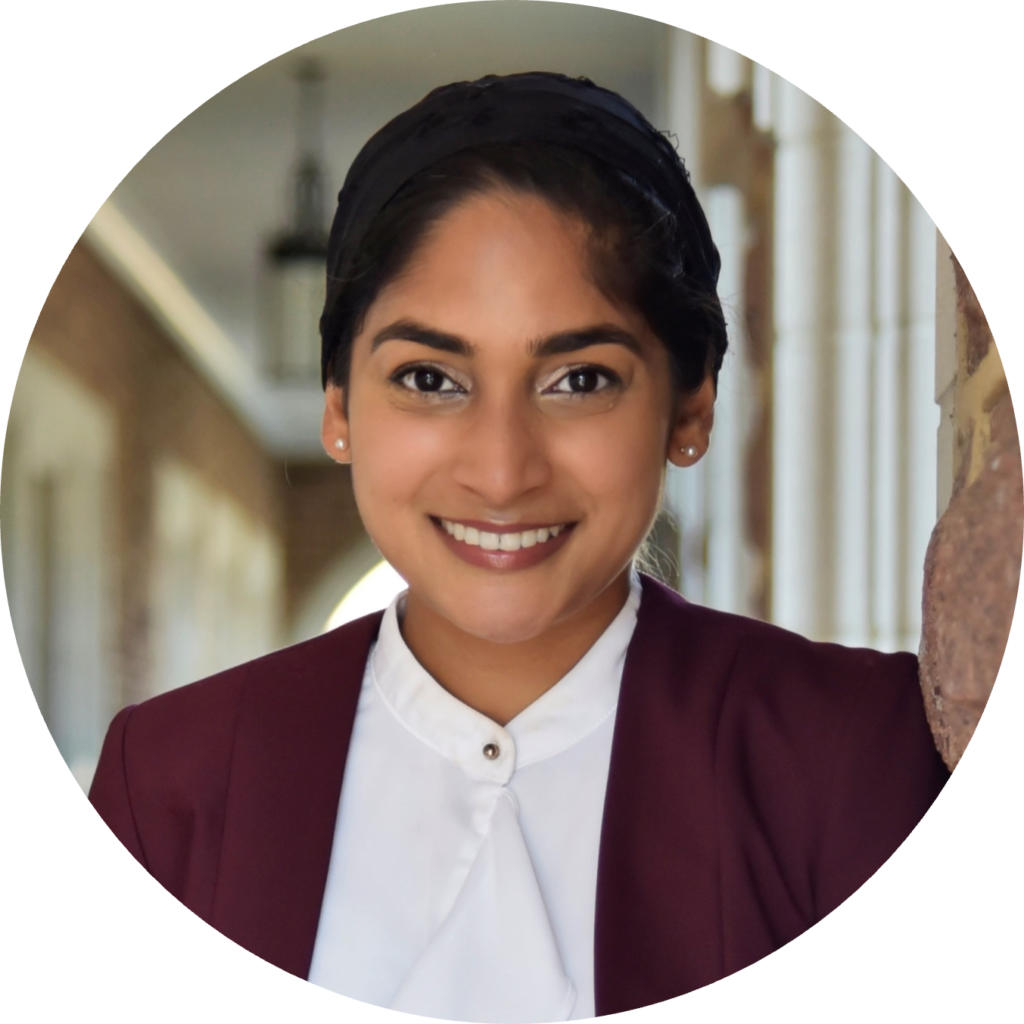
The Women’s Mosque of America:
Authority & Community in US Islam
Tazeen Ali
The following is a modified excerpt from Tazeen Ali’s The Women’s Mosque of America: Authority & Community in US Islam (2022), out now from New York University Press.
The Women’s Mosque of America (WMA) is a multi-racial women-only mosque in Los Angeles that has hosted monthly jummah (Friday prayer) since January 2015. Its emergence speaks to a U.S. mosque culture that systematically marginalizes women through inadequate prayer spaces, exclusion from leadership roles, and limited access to religious education. The WMA aims to empower women and girls through access to Islamic knowledge and leadership opportunities. In early media interviews its founder, comedy writer M. Hasna Maznavi, and then co-president Sana Muttalib, an international law attorney — both South Asian American women — described it as the first women’s mosque in the US.
The WMA promotes an explicitly gendered model of religious authority based on women’s lived experiences that does not replicate existing forms of male authority. WMA policies for khateebahs (female preachers) encourage them to share their vulnerabilities and offer advice on how to overcome personal struggles using the Qur’an and other scriptural sources. Furthermore, on the basis of my field interviews, congregants believed that the khateebahs’ experiences as women lent credence to their authority and qualified them to speak on particular subjects that, in their view, men could not meaningfully engage with.
At the WMA, Muslim women are active mediators of the Islamic tradition. I draw on cultural anthropologist Talal Asad’s concept of Islam as a discursive tradition to theorize Islamic authority as historically contingent and embodied within interpretive communities. The emergent model of authority that I conceptualize here relates to the past, but does not seek to comprehensively imitate it. I consider how WMA members’ interpretive activities fit into academic debates about Islam’s “crisis” of authority. Scholars characterize the crisis of Islamic authority as the fragmentation of authority previously monopolized by the ulama (the Muslim scholarly elite), and its expansion to a range of lay actors since the onset of modernity. As historical anthropologist Zareena Grewal has shown, some U.S. Muslims seek authority through formal credentials: studying Arabic and acquiring ijazas (Islamic certifications) on particular subjects, or attending an Islamic educational institution in the Middle East, Africa, or South Asia. In the process, they construct transnational moral geographies that link their religious identities to a global Muslim community. These U.S. Muslims place Islamic authenticity in a “sacred East.”

Attitudes that equate Islamic authenticity with the “foreign” East situate the U.S. at the periphery of the Islamic tradition and undermine certain American Muslims as legitimate religious actors and potential mediators of the tradition. Islamic studies scholar Aysha Hidayatullah shows that critics discredit a substantial body of feminist exegeses of the Qur’an, produced by Muslims in the secular U.S. academy, as inauthentic based on their “Western” influences. She situates these feminist exegeses at the “edge” of the Islamic tradition, “a place of animated change and the avowal and disavowal of tradition.” The WMA arises from precisely this place of animated change, and resonate with elements of the genre of Muslim feminist exegesis.
Yet it should be noted that the WMA does not brand itself as a feminist space, and indeed has carefully avoided this label. The feminist label, as we will see, is polarizing across many U.S. Muslim communities. It is perceived by some as not authentically Islamic but a product of “Western influence,” despite the fact that, in their scholarship and activism, Islamic feminists have carefully documented the ways in which they draw on Islamic religious teachings and their native cultures to frame their projects. Part of the WMA’s avoidance of identifying as feminist has to do with appealing to mainstream U.S. Muslim communities, or at least attempting not to alienate them. Despite the WMA’s institutional evasion, many congregants and khateebahs happily identify themselves as feminist. At the same time, there is also a broader reluctance among self-identifying U.S. Muslim feminists themselves to identify with other U.S. feminists, especially those who are white, because of anxieties that their own projects might be co-opted by both conservative and liberal imperialist narratives that denigrate Islam. For this reason, Black feminist and womanist scholarship that incorporates intersectionality as a way to work toward women’s liberation while also combatting white supremacy provides a useful frame to think about the “feminist” moves of WMA actors, while still acknowledging the broader ambivalence many of them may have toward a feminist label.
Recognizing how the WMA emerges from the genre of U.S. Muslim feminist exegesis and using Black feminist and womanist frameworks to situate their interpretive activities provides an opportunity to analyze the U.S. as at the center, rather than the periphery, of debates over Islamic authority. Emphasizing the U.S. as an integral site for Islamic studies debates over authority allows us to take seriously American Muslims’ engagements with their religious tradition. It also allows us to recognize American Muslims, particularly women, as legitimate religious actors in the fabric of U.S. society. Therefore, this book contributes to a deeper understanding of authority within both the global Islamic and the American religious landscapes.

The Women’s Mosque of America. Photo taken by Faezeh Fathizadeh, The Pluralism Project, Harvard University.
Moreover, since the 2016 presidential election, white nationalism, misogyny, and Islamophobia have returned to the public sphere in full force. Alongside these trends, the stereotype of the subjugated Muslim woman has reemerged in American public discourse. The WMA draws attention to new ways that American Muslim women are constructing religious authority by renegotiating normative assumptions around women’s roles in their communities. American Muslim women who take issue with the marginal status of women in their religious communities are in a particularly tenuous position as they must negotiate change within their communities against the precipitous rise of Islamophobia in the US.
Seriously considering American Muslim women’s recent engagements in cultivating religious authority provides an important scholarly opportunity to advance the study of Islam and gender beyond simply advocating for national belonging or dispelling negative stereotypes. In this book, I treat members of the WMA as meaningful actors within the fabric of American religious life rather than as exemplars meant to validate the broader Muslim presence in liberal societies. In so doing, I show how women at the WMA legitimize specific ways of being American Muslims. Furthermore, since the WMA is a multiracial community, I also examine the internal dynamics of the historically tense relationships between Black and immigrant Muslims (including those of first and subsequent generations) in the U.S. As religious minorities in the U.S., Muslims are racialized as political others. Congregations develop in relation to hegemonic whiteness, which in turn has a profound effect on the relationships among Muslims of different racial and ethnic backgrounds. This book engages with debates over religious pluralism, by attending to the uneven balance of power that affords some religious groups authoritative positions in interfaith dialogue while marginalizing others.
To be clear, I do not suggest that the WMA creates a new sui generis form of religious authority. Members of the WMA cultivate authority in ways that resemble earlier precedents from non-Muslim and Muslim contexts both in the U.S. and globally. The WMA also shares a common orientation with contemporary U.S. Muslim third spaces, which typically function as replacements for, or complements to, established mosques that do not meet the needs of all of their community members. Third spaces differ from first and second spaces, like home and school respectively, or in this case, home and the mosque, by adopting a hybrid of both practical everyday learning and more formalized knowledge. As Justine Howe shows, Muslim third spaces can transform modes of pious practices in US Islam by questioning existing modes of authority. She categorizes Muslim third spaces as sites structured by alternate modes of authority, textual engagements, and ritual expression. By these criteria, the WMA would be considered a third space; however, in its own narrative, it identifies as a mosque. By branding itself as a mosque rather than as a third space, the WMA attempts to redefine what a mosque community should look like.
The individual features of the WMA — a place where women lead prayer, use English translations to interpret scriptures, draw on their own experiences as a key exegetical method, build multiracial Muslim solidarity rooted in social justice concerns, and cultivate interfaith ties — are not new or unique features independent of each other. Yet the combination of these methods represents a form of authority that is indeed distinctive. The particular constellation of features of authority at the WMA continually shifts and adapts to new challenges and community pressures. The WMA therefore provides us with an opportunity to think about new directions in Islamic authority, ones in which English translations and women’s experiences are valued in Qur’anic exegesis over Arabic language expertise and formal credentials and where social justice activism is prioritized as a moral imperative, and interfaith relationships are cultivated as a result of, but also to combat, a broader climate of Islamophobia. In other words, women at the WMA make conceivable a kind of lay American Islamic authority that is an alternative to hegemonic models of authority rooted in maleness, Arabic language expertise, and formal credentials.
The Women’s Mosque of America: Authority & Community in U.S. Islam examines how gender is continually constructed and performed. I employ the concept of gender as a meaningful category of analysis to investigate the WMA’s own assumptions about gender and sexuality. Given the racial and ethnic diversity of the WMA preachers and congregants, as well as its emphasis on social justice, I take seriously in my analysis the categories of both gender and race, which never operate separately. Moreover, I see Islamophobia, which is particularly gendered and racialized in the US, as an important context against which members of the WMA justify their decisions. I argue that the WMA produces a distinct model of Islamic authority that is informed by the U.S. context but also speaks to global Islamic trends. ♦

Tazeen M. Ali is a scholar of Islam and gender in the United States and assistant professor of religion and politics at the John C. Danforth Center at Washington University in St. Louis. Her research and teaching focus on Islamic studies at the intersections of gender and sexuality, race and religion, and media representation in America.
Recommended Citation
Ali, Tazeen. “The Women’s Mosque of America: Authority & Community in US Islam.” Canopy Forum, November 25, 2022. https://canopyforum.org/2022/11/25/the-womens-mosque-of-america-authority–community-in-us-islam/.

